Keep Calm and Save Ukraine

Top Python frameworks for web development in 2022
This article is the third in a series of articles on web development and the most popular backend programming languages and frameworks. If for some reason, you missed our previous releases, you can find them in our Insights section. They cover such topics as PHP and its frameworks and advanced features of Node.js and Next.js. Today we will consider one of the most popular programming languages, ranked number 1 by The Github PYPL Index, Python. Why is Python so popular? What frameworks do Python development companies use? These are some of the questions we are going to cover here.
Python
Python is a scripting programming language of universal nature with dynamic semantics that enables it to solve various tasks of different complexity for a wide range of platforms. Developed by Guido van Rossum in the early nineties at CWI (National Research Institute for Mathematics and Computer Science) in Amsterdam, it has quickly gained credibility among developers due to its improved productivity, flexibility, and a rich pool of frameworks and libraries.
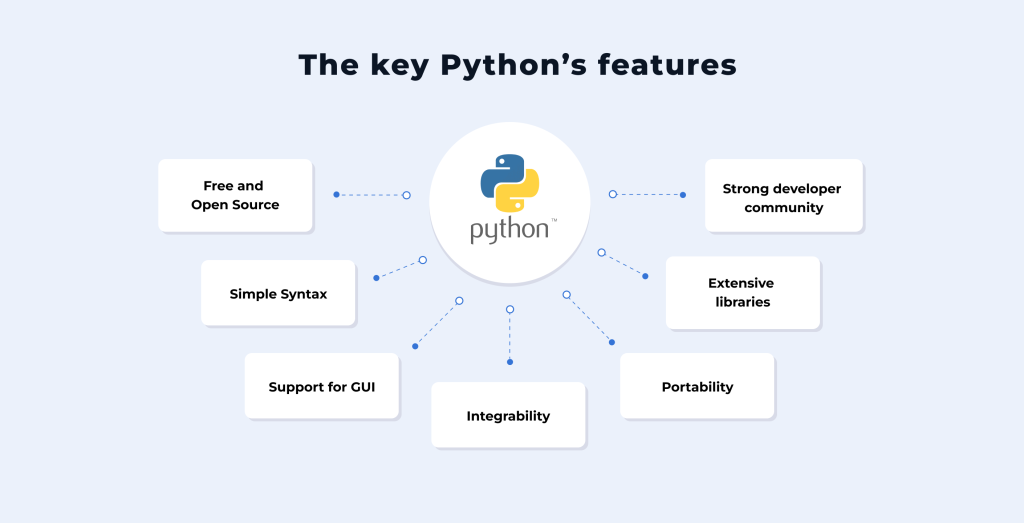
Advantages of Python programming language over others include:
Free and Open Source. Under Python’s license, this language is easily available, distributed, and applicable. Its ecosystem is fast-growing and includes many open-source packages. Installing Python on a computer does not take much time and does not require additional actions and costs. All you need to do is go to their official website and download it for free.
Simple Syntax. Python syntax is very similar to English, which makes it much easier to understand and use. Its syntactic feature also allocates code blocks by indents to simplify the visual perception of programs written in this language.
Support for GUI. The Python GUI library comprises various tools for building GUI-based apps. PyGui, Toga, VTK, Kivy, and Tkinter are just a few frameworks this language provides to support the creation of graphical user interfaces.
Integrability. Python is highly extensible and can be easily integrated with other programming languages such as C, C++, C#, Java, ActiveX, Go, etc. Besides, it is possible to blend it with available technologies to enable a team to perform simultaneously on the same solution.
Portability. The same code can be used on different machines when developing a project in Python. Thus, a person can run Python solutions across various operating systems (Windows, Linux, Mac) without changing or rewriting the program code. Also, a Python interpreter can easily convert Python’s source code into bytecode executed on platforms.
Extensive libraries. In addition to the standard library, Python has access to a large pool of additional ones, the most popular of which are Numpy and SciPy (for scientific computing and machine learning development), Pandas (for data analysis), Keras and Seaborn (for machine learning and natural language processing), Pygame (for developing multimedia applications and games), and others.
Strong developer community. One of the crucial factors in the rapid spread of Python is the large community of developers and enthusiasts who regularly update and make changes in the existing documentation and practical implementation cases. Python has its clearly regulated documentation PEP (Python Enhancement Proposal), describing its new features and document aspects.
What is Python used for?
Due to its adaptability, Python may be used in various applications across numerous branches. Let’s look at some areas where developers widely use python programming.
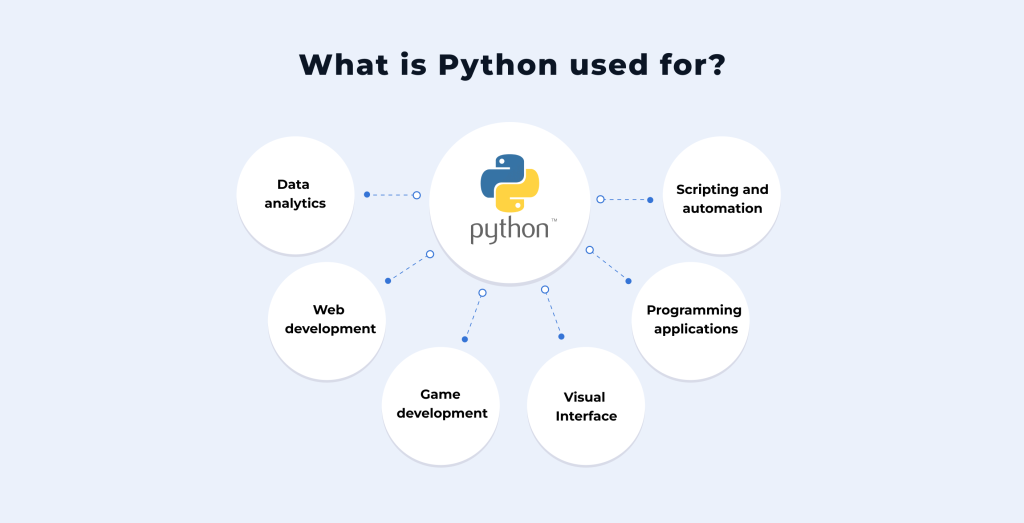
Data analytics. Python was initially created to interact with any database as simply and clearly as possible. Its simple syntax, third-party libraries integration, and programming interface for working directly in the script via SQL queries greatly simplify the data processing work.
Web development. Building a web application in Python is easy and fast because of its remarkable frameworks, such as Django, FastAPI, or Flask, with extensive libraries. They greatly simplify generating the HTML pages users see in their browsers, database queries, address processing, data authorization, and many others. Famous services Mozilla and Spotify were created on them.
Game development. Although Python is far from standard in game development, and it is impossible to create a large project on it alone, it still finds its use in this environment. A programmer can write small applications and simple games, create a dialogue tree, and much more. Battlefield 2, World of Tanks, and Civilization IV are some examples where Python has been involved. Many also regard this language as a valuable tool for rapid prototyping.
Visual Interface. The Python programming language can also solve many graphical tasks thanks to a vast pool of libraries, among which you can choose the one that best suits your needs. For example, if there is a demand to adapt the created graphical interface to the application’s operating system, then the Dabo library is optimal.
Programming applications. Python has been used for writing programs for many years. With it, developers can speed up the opening and search of files in folders, running programs, computing, creating GUIs, APIs, or file directories, etc. Any kind of application, from audio to machine learning apps, can be developed with Python.
Scripting and automation. Scripting is writing code to automate simple tasks, which is used to check for errors in many files, perform simple math tasks, test software, and remove duplicates in data. These can be additional modules, plug-ins for ready-made software, etc.
The Powercode team has analyzed Python’s most popular website frameworks and wants to share gained information with you. Python frameworks are generally developed to reduce development time and allow programmers to focus mainly on application logic. We will examine the two most relevant frameworks for 2022. Each has its own pros and cons and specific areas of implementation.
Django
General Facts
Django is a free, open-source, high-level Python-based web framework that builds fast and secure applications and websites. Developed in 2003 by experienced programmers at the Lawrence Journal-World, it enables developers to work with any client environment and deliver content in various formats (HTML, JSON, RSS feeds, etc.). Django has continued to expand and improve since its first release in September 2008 to the recently released version 4.1.2 (2022). Each version adds new functionality and fixes bugs, ranging from support for new database types to adding “common” view functions and classes.
The initial framework’s goal was to meet strict deadlines and keep the development process sustainable. Now, it aims at enabling developers to create a complex and maintainable website easily and fast.
Target Projects and Confidence Level
When you start examining the framework, you ask yourself: what is Django used for? As it was built by the team that worked on developing and servicing websites for newspapers, it is perfect for publishing projects. Also, due to its high performance, customization features, and the possibility to manage massive data and traffic, it is used for a wide range of applications.
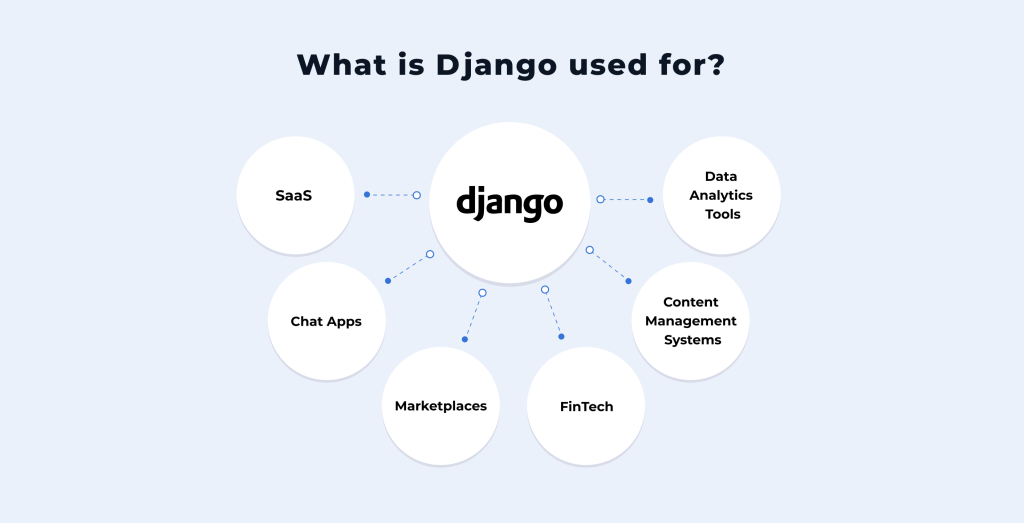
Here are some django project ideas.
SaaS. SaaS is a method of licensing software in which access to the program is granted on a subscription basis, and the program is stored on external servers. The Django framework is an appropriate option for developing SaaS solutions due to its various features, such as customization, integration with Python libraries, reusability, scalability, and many others.
Chat Apps. The main goal of chat applications is to provide regular communication in real-time. Though Django is used for creating servers for HTTP connections, regarded as unsuitable for chatting apps, its channels and WebSockets implementation change the situation. WebSockets uses Django channels, with the help of which a developer builds an ASGI server and a group of users to send messages in real-time. Besides, it is possible to use databases and built-in user models to store all messages in one place.
Marketplaces. Marketplaces are e-commerce websites connecting sellers with buyers, which require fast and solid coding. Hundreds, thousands, or even millions of transactions are made daily. That is why the aspects of traffic, multitasking, and load distribution are crucial when building marketplaces. Python-based web framework Django is distinguished by its reliability, efficiency, fast development, and high performance, which makes it exceptional when working with Ecommerce projects.
FinTech. FinTech solutions are developed to satisfy growing customers’ and owners’ demands. The first expects fast servicing, prompt money transfers, and lending, and the second needs stable tangible and intangible resource management. Django also has built-in security features that allow developers to forget about inventing a way to ensure app security.
Content Management Systems (CMS). In addition to Django, there is also a separate WordPress similar framework written in Django/Python, Django CMS, used to create websites adjusted to the demands of clients. Being exercised by such global giants as L’Oreal and NASA, it enables developers to manage a website and its content with built-in tools without having to create a separate admin page.
Data Analytics Tools. CMR gathers and examines data on a company, its clients, and/or opponents to enhance business operations and reveal new information for decision-making based on retrieved figures. The Django framework is a powerful tool for conducting analysis and working with a big data pool with various statistical and analytical libraries and resources. For example, Django Numpy, Django Statsd, Django-Trackstats, and others.

Currently, there are a large number of popular websites created using Django, among them:
- NASA. The National Aeronautics and Space Administration (NASA) is responsible for developing scientific and technological advancements in human space-flight aeronautics and space science. The website has a complex structure with high-resolution imagery and a significant number of monthly visitors. So, NASA uses Django to ensure that functional elements run reliably and efficiently.
- National Geographic. National Geographic is a popular TV channel and magazine addressing science, nature, culture, and discoveries. Their website incorporates many videos, images, and links to other resources. Django helps manage this complex data; its CMS is used for National Geographic’s Education page.
- Spotify. Spotify is a music streaming platform with more than 300 listeners per month, enabling users to get access to huge music libraries. They have chosen Django for its AI options, exceptional speed, and community support.
- Instagram. Instagram is one of the most popular social media networks uniting many users and media data. Its developers have preferred Django to guarantee the smooth operation of the app and fix issues immediately.
- Mozilla. As one of the most popular web browsers, Mozilla has started using Python Django to handle its vast traffic (more than hundreds of millions of views per month) and API hits daily. Django is also used in a support site and add-ons.
- The Washington Post. As Django was created to enhance the operation of a newspaper, it is not a surprise that one of the most powerful newspapers has preferred it for handling its traffic and workload.
- Robinhood. Robinhood is a financial system created to let people start investing at their own pace and terms. Its main spheres are cryptocurrency, stock, and currency-exchange trading. Django ensures the smooth running of the app.
Strengths and Weaknesses of Django
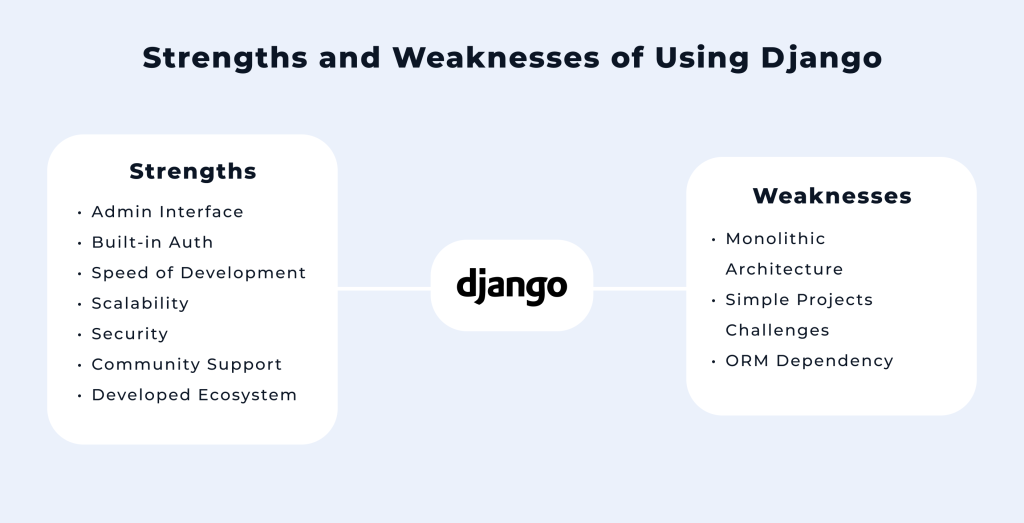
Django’s top advantages over other backend web frameworks are a large set of ready-made features allowing programmers to implement forums and search systems into a site quickly, build advanced registration systems, etc. Now we will examine the main ones.
Benefits of Using Django
| Admin Interface | Django’s admin interface is a robust, utterly customized admin area protected by a login and reflecting all data related to a person’s application. It is organized so that it enables users to see all tables – those they store there and those located by third-party packages. |
| Built-in Auth | Authentication is a crucial component of any application that can be realized in various ways depending on the requirements and ultimate goals. The Django framework simplifies this task by providing developers with built-in auth via either sessions or DRF (Django REST framework) library implementation for token authorization. Both options are simple and do not need much additional configuration. |
| Speed of Development | Django is based on the Don’t Repeat Yourself principle allowing developers to reuse the current code to make it meet new requirements. Taking all the advantages of Python and supplementing them with its built-in features (libraries, plugins with a common API, etc.), it has become much easier and faster to create websites and web applications with the help of this framework. |
| Scalability | The peculiar feature of Django architecture is the independence of its components. Any component can be replaced or modified without disturbing other elements. The framework neatly separates the database and application layers. If a developer needs to scale a project as traffic grows or load increases, it is possible to do without additional effort. |
| Community Support | The Django community has been building for more than 17 years. Developers from all over the world have come together to support the establishment of the framework. Community members try to keep the code updated and bugs fixed. Both newcomers and skilled professionals can find answers to their questions or ask for help in such sections as Django Q&A or Community blog posts. Finding a Django job or examining New/updated Django packages is also possible. |
| Security | Django has many built-in security features to protect it from malicious attacks and enable developers to allocate data access according to users’ permission levels. Thus, it increases the operational stability and security of the project. An important role is also played by an advanced authentication system that meets modern requirements for managing user accounts and passwords. |
| Developed Ecosystem | For Django, there are a large number of third-party plugins, various instructions, etc., that a developer can choose and include depending on the customer’s demands. In addition, there is an opportunity to use elaborate documentation, which helps a lot in understanding all the nuances of the framework. |
Weaknesses of Django
| Monolithic Architecture | One of the specific features of the Django framework is that though it has a rich set of built-in tools, it is rather difficult to modify some of its modules. It is a time- and effort-consuming process. Many developers claim that working with Django allows them to concentrate exclusively on the project rather than sophisticated programming. |
| Simple Projects Challenges | Initially, Django was developed for creating large projects within a short time. Thus, its processes, bandwidth requirements, processing time, etc., can be redundant for a project of smaller size and with lower standards. You have to refer to another framework that suits your demands better, for example, FastAPI or Flask. |
| ORM Dependency | Django’s ORM system currently lacks support for key crucial functionalities even though it allows developers to access databases and perform operations. It is appropriate for dealing with queries of either low or medium complexity. But if you regard SQLAlchemy, a Python SQL tool, as the essential one for your project, you will not find it here. |
FastAPI
General Facts
FastApi is used to develop HTTP APIs with built-in serialization, asynchrony, and validation. It is light, uncluttered, and with a good set of functionality. It makes it possible for programmers to build and implement pure Python web applications rapidly and effectively. It benefits from using the ASGI standard to communicate with customers asynchronously. If required, the FastAPI framework can adopt WSGI. To start working with FastAPI, you will need an ASGI server.
FastApi’s key benefits include its simplicity, fast coding, incorporated documentation, simplicity of use, lack of learning problems, and extensive editor support.
Target Projects and Confidence Level
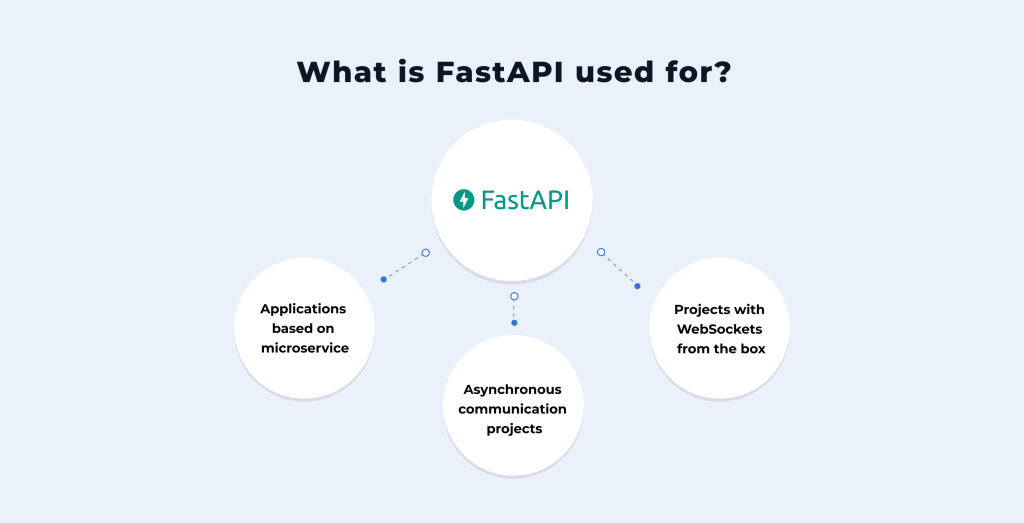
FastAPI Python is perfect for the following solutions:
Applications based on microservices. Microservices Architecture has become one of the most profitable in recent times. Because businesses can autonomously create, deploy, and scale a microservice without affecting other components of the software or modifying other parts, the microservices architecture enables more flexibility. Many global companies like Uber or Netflix have decided to follow this principle and stop using monolithic solutions as they want to enjoy scaling and responsive benefits.
Asynchronous communication projects. Unlike synchronous communication, asynchronous one occurs in non-real-time. Various asynchronous client-to-server communications may take place concurrently or even in sequence with each other. Such apps do not use blocking and send numerous requests to a server. Asynchronous communication includes emails, and comments on various forums, corporate intranet, and many others. Business messaging apps often combine both techniques, for example, Asynchronous Standups in Slack, G-suite tools, Trello, Asana, etc.
Projects with WebSockets from the box. WebSocket enables the TCP connection to be kept operational so that data can be sent back and forth between the server and client without establishing a new connection each time. It reduces network traffic by removing unnecessary operations.
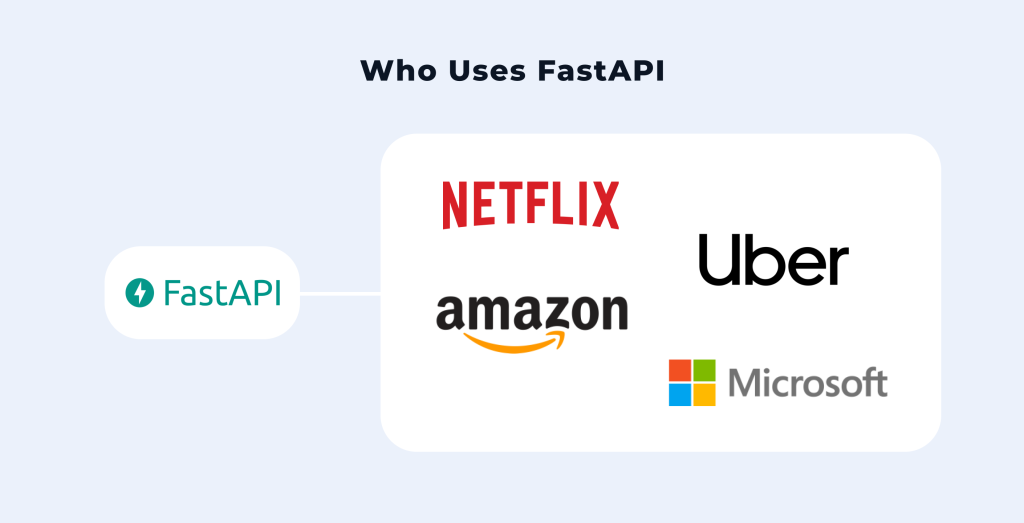
The list of top companies implementing FastApi is vast and includes the following:
- Microsoft. One of the largest and oldest American multinational computer technology corporations uses FastApi and all its features.
- Amazon. An Internet retail giant had to recreate its system to make it more flexible and responsive. They decided to break its application into several smaller and independent service apps with the help of FastAPI features. The site’s functionality has been improved, enabling developers to change individual features.
- Netflix. Having started its movie streaming service, the company had faced scaling challenges by 2008. At that moment, the company’s top management thought about moving to a microservice architecture, which was fully achieved in 2012. An American subscription streaming service and production company used FastApi to build their app, including authentication and Netflix’s Dispatch.
- Uber. This famous transportation company uses FastApi to develop its advanced app allowing passengers to order a car and drivers to charge fares. They can scale easier, concentrating only on the areas that require changes.
Strengths and Weaknesses of the FastAPI Framework
To understand the strong and weak sides of the FastAPI framework, our specialists have gathered all its cons and pros. Now we are ready to share them with you.
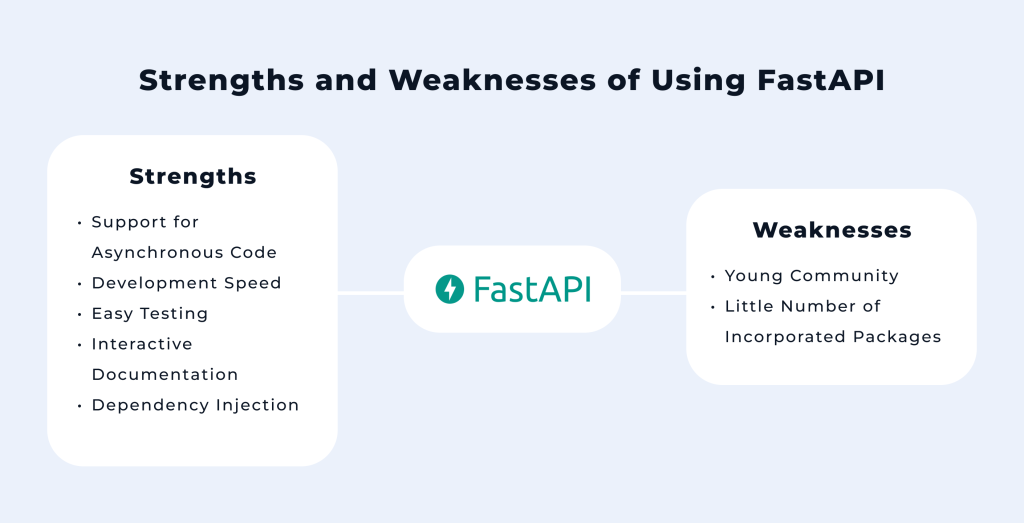
Benefits of Using FastAPI
| Support for Asynchronous Code | Writing asynchronous code in FastAPI is a powerful and valuable feature enabling it to improve both code and application performance and increase responsiveness. It is realized via the async/await Python keywords. |
| Easy Testing | Testing FastAPI applications is straightforward and delightful, thanks to Starlette, a lightweight ASGI toolkit. Because it is based on a simple HTTP library for Python called Requests, testing is also friendly and comprehensible. |
| Interactive Documentation | FastAPI provides users with a highly practical, interactive, and automatic documentation system integrating Swagger UI. A developer also has the right to type in ReDoc and get the alternative API documentation aimed to facilitate their work and explain some challenging issues. For example, it makes the process of testing more convenient. |
| Development Speed | FastAPI has fast code, which can increase overall development speed by 200%.
|
| Dependency Injection | Dependency injection (DI) is a process of providing an external dependency to a software component. It’s a technique for obtaining control inversion, improving the code’s modular character, and increasing system scalability. FastAPI provides a straightforward and user-friendly DI. Developers can easily specify pertinent dependencies in FastAPI’s path operation functions allocated to API endpoints. |
Weaknesses of FastAPI
| Small community | Being a relatively new framework, FastAPI hasn’t established an advanced community of developers yet. This can be explained by the lack of mature documentation like other Python frameworks have. Although it is presented in a convenient automatic form, it is still under development, and a person needs to spend time searching for answers to questions. |
| The Small Number of Incorporated Packages | Considering that FastAPI is mainly used for fast and effortless website building, it does not have many packages, especially compared with Django, a full-stack web development framework. |
Final Remarks
This is our third article in the series on top backend frameworks for web development in 2022. Through it, our Powercode team has shared their deep knowledge about two Python-based web development frameworks, Django and FastAPI. Both of them have their own features that make them stand out from each other and other frameworks. FastAPI is the perfect option if you’re searching for a swift and highly operational framework due to its sophisticated adaptability. And with more than 2,500 packages in its library, Django is the ideal option if your goal is a full-stacked Python-based web application development framework. Moreover, it provides a broad range of options and features that developers can use to create various functionalities.
Depending on your needs, you can select any of these frameworks. If you do not know what best suits your requirements, then immediately contact us so that our specialists will get in touch with you within 24 hours, and you will receive answers to all your questions.

